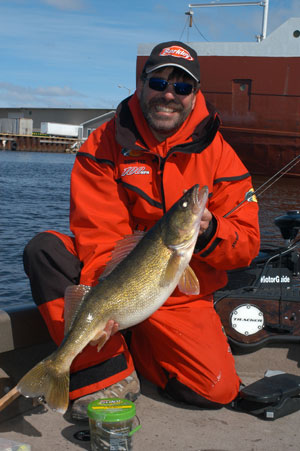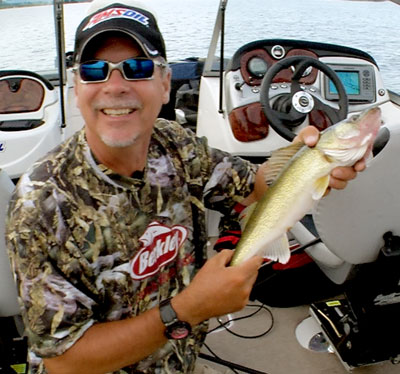If you’re anywhere close to a river, one that is well populated with walleyes, now is the perfect time to hit the water for the season’s first walleye action (as long as the walleye season is open on rivers in your area). Rivers are the first waters to thaw in the spring, and the walleyes will be on the move into potential spawning areas. That makes for good numbers of fish located in very predictable areas and that means really good fishing. However, getting out on the river still isn’t remedy enough to cure a true case of Walleye Fever.
How are you feeling lately? Perhaps a bit fatigued, irritable, maybe noticing an insatiable desire to spend endless hours sharpening hooks, watching TV fishing shows and videos, and pouring over magazines filled with stories describing the newest tackle and techniques for catching fish. You’re not alone … many suffer from this ailment during the late-winter/early spring season. It’s Walleye Fever, and if you’re any kind of walleye angler, chances are you’re experiencing at least some of the described symptoms mentioned. Some of those inflicted try treating it by ice fishing, but that’s sort of like using an ice pack to sooth a spiking temperature … the relief is only temporary. Not to worry though, it’s rarely fatal, and the cure is an easy-to-swallow pill.
 If you’re anywhere close to a river, one that is well populated with walleyes, now is the perfect time to hit the water for the season’s first walleye action (as long as the walleye season is open on rivers in your area). Rivers are the first waters to thaw in the spring, and the walleyes will be on the move into potential spawning areas. That makes for good numbers of fish located in very predictable areas and that means really good fishing. However, getting out on the river still isn’t remedy enough to cure a true case of Walleye Fever. It takes a full dose of the medicine to truly be cured. In other words, you need to catch some fish, and early season catching calls for the right prescription; the right tackle and techniques to put the walleyes in the boat.
If you’re anywhere close to a river, one that is well populated with walleyes, now is the perfect time to hit the water for the season’s first walleye action (as long as the walleye season is open on rivers in your area). Rivers are the first waters to thaw in the spring, and the walleyes will be on the move into potential spawning areas. That makes for good numbers of fish located in very predictable areas and that means really good fishing. However, getting out on the river still isn’t remedy enough to cure a true case of Walleye Fever. It takes a full dose of the medicine to truly be cured. In other words, you need to catch some fish, and early season catching calls for the right prescription; the right tackle and techniques to put the walleyes in the boat.
Location is the first key to finding the cure. Look for walleyes to hold in reduced current areas near spawning flats. These spots are created by some sort of current break like a point or rock jetty jutting out into the channel, a sand bar, a delta caused by an incoming creek, or even the inside corner of a river bend. If you’re fishing near a dam, the outside edges of the spillway often offer reduced current that holds fish. Any of these areas can also create back eddies that are notorious for holding lots of fish. River walleyes prefer some current to bring food to them, but not so much that they have to work too hard to fight it. Even a depression in the bottom can be a holding area, where the fish will lay in wait for a potential meal to pass overhead.
The most efficient tactic to target these early spring walleyes is vertical jigging. This is a technique where the angler fishes a jig (usually tipped with a minnow) directly below the boat while moving down-current in the river. The idea is to keep the presentation as vertical as possible as this will increase your over-all feel allowing the detection of bites and identification of bottom cover as you drift.
 The biggest mistake many anglers make is to try to maintain a vertical presentation by going to a heavy jig. That does two things … it makes it tougher for the fish to take the bait into its mouth, and because you end up fighting the current instead of flowing with it, you don’t present the bait in a way walleyes are used to seeing their prey. They eat things that are traveling the same speed as the current, and that’s the way you want to present your jig. The best way to do this is to use a lighter jig (1/4 to 3/8 ounce are the bread-and-butter sizes), and utilize your bowmount electric motor to “follow your fishing line”. In other words, if you see your line swinging to the left or right, use your bowmount to move the boat until the line is vertical again. We use a technique called “Bursting”, where we set our trolling motor on about 80% power, and correct the boat’s drift with short powerful bursts. This way we use less time and energy keeping our baits vertical at all times.
The biggest mistake many anglers make is to try to maintain a vertical presentation by going to a heavy jig. That does two things … it makes it tougher for the fish to take the bait into its mouth, and because you end up fighting the current instead of flowing with it, you don’t present the bait in a way walleyes are used to seeing their prey. They eat things that are traveling the same speed as the current, and that’s the way you want to present your jig. The best way to do this is to use a lighter jig (1/4 to 3/8 ounce are the bread-and-butter sizes), and utilize your bowmount electric motor to “follow your fishing line”. In other words, if you see your line swinging to the left or right, use your bowmount to move the boat until the line is vertical again. We use a technique called “Bursting”, where we set our trolling motor on about 80% power, and correct the boat’s drift with short powerful bursts. This way we use less time and energy keeping our baits vertical at all times.
The style of jig you use will play a key role in your Fever treatment as well. For vertical jigging, a jig with a long hook shank will increase your hooking percentage over those with short shank hooks. The longer shank gives the jig a “cam” action on the hook set that helps to drive the hook into the fish’s mouth. Standard round-head jigs work fine in many cases, but if you are looking to treat your Fever in the best fashion possible, a jig with a “semi-stand-up” head design definitely offers a few advantages. Jigs like the Bass Pro Shop’s XPS Jig put the hook and trailing bait just off the bottom in perfect position for a walleye to suck it in with little effort. This is especially helpful when most of your bites are coming as the jig sits on the bottom between jigging motions.
The final ingredient in the prescription is dress your jig for success. A lively minnow is one great option. Another great option for tipping your jig is to use an artificial bait either in conjunction with the live bait or alone. It’s amazing how many anglers are switching to artificials on jigs. Baits like the Berkley Gulp!® 3 inch Minnow and the Berkley Gulp!® 3 inch Fry are ideal for tipping jigs in these situations. These baits are not plastic, but rather a biodegradable material that gives off a scent trail in the water just like live bait does. The big advantages are that these stay on the hook better than a live minnow, you’re not having to dip your hands in the minnow bucket all the time on a cold day, and the scent dispersion actually lasts longer in the water than with live bait, which in turn can stimulate bites from less than active walleyes in the area you’re fishing (sort of a “chumming” effect).
It’s been a long winter, and chances are the Walleye Fever has a tight grip on you too. But if there’s a river near by, the cure is as simple to swallow as a leech dipped in olive oil. The Walleye Doctor’s prescription is to just gather up your jigging tackle and head for the water. Once you feel the “tick” and hook into a few dandy walleyes, you will be cured.










